队列( Queue )是操作受限的线性表.限定在表的一端插入(入队),另一端删除(出队),特点是数据元素先进先出( FIFO First in First Out)。
重要术语:空队列、满队列、入(进)队、出(离)队、队头(允许删除的一端)、队尾(允许插入的一端)。

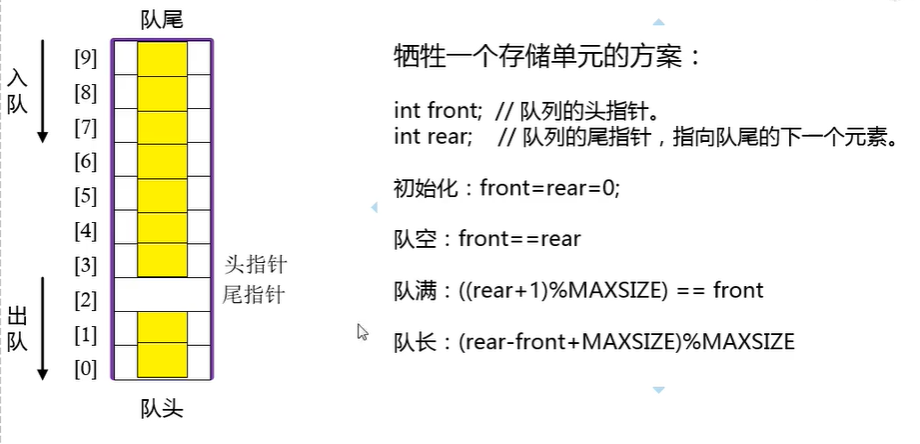
一、定义一个结构体
#include <stdio.h>
#include <string.h>
#define MAXSIZE 10 // 循环队列的最大长度,最多可以存放MAXSIZE-1个元素。
typedef int ElemType; // 自定义循环队列的数据元素为整数。
typedef struct
{
ElemType data[MAXSIZE]; // 用数组存储循环队列中的元素。
int front; // 队列的头指针。
int rear; // 队列的尾指针,指向队尾的下一个元素。
}SeqQueue,*PSeqQueue;
int main()
{
return 0;
}
二、创建循环队列并初始化
// 循环队列QQ的初始化操作。
void InitQueue(PSeqQueue QQ);
// 清空循环队列。
void Clear(PSeqQueue QQ);
int main()
{
SeqQueue QQ; // 创建循环队列。
InitQueue(&QQ); // 初始化循环队列。
return 0;
}
// 初始化循环队列
void InitQueue(PSeqQueue QQ)
{
Clear(QQ); // 清空循环队列。
}
// 清空循环队列。
void Clear(PSeqQueue QQ)
{
if (QQ == NULL) return; // 检查空指针。
QQ->front=QQ->rear=0;
memset(QQ->data,0,sizeof(ElemType)*MAXSIZE); // 数组元素清零。
}
三、创建一个数据元素。
int main()
{
SeqQueue QQ; // 创建循环队列。
InitQueue(&QQ); // 初始化循环队列。
ElemType ee; // 创建一个数据元素。
return 0;
}
四、队列的长度
// 求循环队列的长度,返回值:>=0-队列QQ元素的个数。
int Length(PSeqQueue QQ);
int main()
{
SeqQueue QQ; // 创建循环队列。
InitQueue(&QQ); // 初始化循环队列。
ElemType ee; // 创建一个数据元素。
printf("队列的长度是%d\n",Length(&QQ));
return 0;
}
// 求循环队列的长度,返回值:>=0-队列QQ元素的个数。
int Length(PSeqQueue QQ)
{
if (QQ == NULL) return 0; // 检查空指针。
return (QQ->rear-QQ->front+MAXSIZE)%MAXSIZE;
}
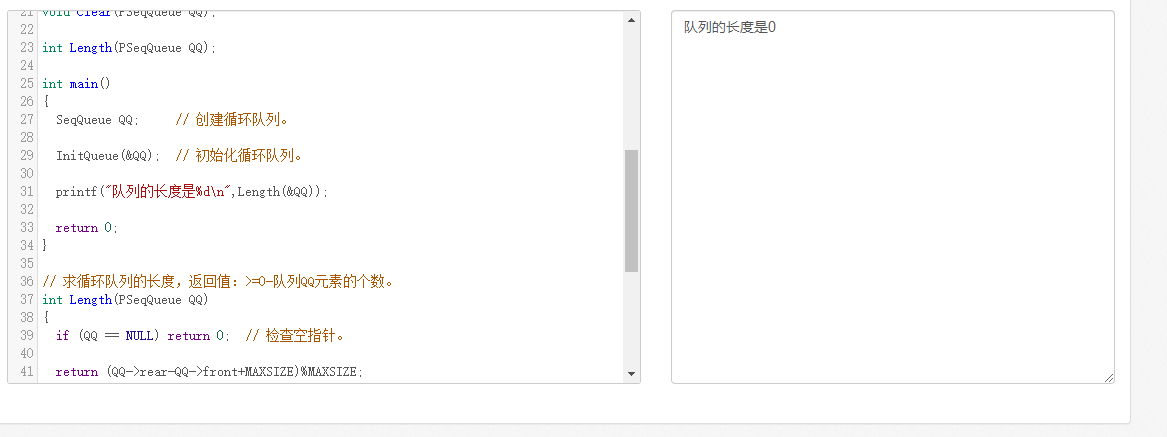
五、入队
// 元素入队,返回值:0-失败;1-成功。
int InQueue(PSeqQueue QQ, ElemType *ee);
// 判断循环队列是否已满,返回值:1-已满,0-未满或失败。
int IsFull(PSeqQueue QQ);
int main()
{
SeqQueue QQ; // 创建循环队列。
InitQueue(&QQ); // 初始化循环队列。
ElemType ee; // 创建一个数据元素。
printf("元素(1、2、3、4、5、6、7、8、9、10、11)入队。\n");
ee=1; InQueue(&QQ, &ee);
ee=2; InQueue(&QQ, &ee);
ee=3; InQueue(&QQ, &ee);
ee=4; InQueue(&QQ, &ee);
ee=5; InQueue(&QQ, &ee);
ee=6; InQueue(&QQ, &ee);
ee=7; InQueue(&QQ, &ee);
ee=8; InQueue(&QQ, &ee);
ee=9; InQueue(&QQ, &ee);
ee=10; InQueue(&QQ, &ee);
ee=11; InQueue(&QQ, &ee);
printf("队列的长度是%d\n",Length(&QQ));
return 0;
}
// 判断循环队列是否已满,返回值:1-已满,0-未满或失败。
int IsFull(PSeqQueue QQ)
{
if (QQ == NULL) return 0; // 检查空指针。
if ( ((QQ->rear+1)%MAXSIZE) == QQ->front) return 1;
return 0;
}
// 元素入队,返回值:0-失败;1-成功。
int InQueue(PSeqQueue QQ, ElemType *ee)
{
if ( (QQ == NULL) || (ee == NULL) ) return 0; // 检查空指针。
if (IsFull(QQ) == 1)
{
printf("循环队列已满,不能插入。\n"); return 0;
}
memcpy(&QQ->data[QQ->rear],ee,sizeof(ElemType)); // 用数组的下标访问。
// memcpy(QQ->data+QQ->rear,ee,sizeof(ElemType)); // 采用指针运算也可以。
QQ->rear=(QQ->rear+1)%MAXSIZE; // 队尾指针后移。
return 1;
}
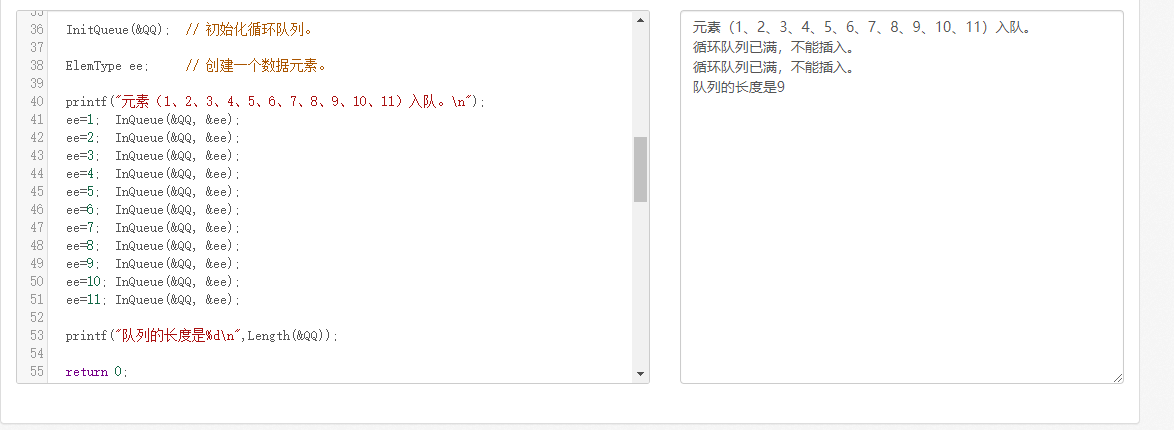
六、查看队列元素
// 判断循环队列是否为空,返回值:1-空,0-非空或失败。
int IsEmpty(PSeqQueue QQ);
// 打印循环队列中全部的元素。
void PrintQueue(PSeqQueue QQ);
int main()
{
SeqQueue QQ; // 创建循环队列。
InitQueue(&QQ); // 初始化循环队列。
ElemType ee; // 创建一个数据元素。
printf("元素(1、2、3、4、5、6、7、8、9、10、11)入队。\n");
ee=1; InQueue(&QQ, &ee);
ee=2; InQueue(&QQ, &ee);
ee=3; InQueue(&QQ, &ee);
ee=4; InQueue(&QQ, &ee);
ee=5; InQueue(&QQ, &ee);
ee=6; InQueue(&QQ, &ee);
ee=7; InQueue(&QQ, &ee);
ee=8; InQueue(&QQ, &ee);
ee=9; InQueue(&QQ, &ee);
ee=10; InQueue(&QQ, &ee);
ee=11; InQueue(&QQ, &ee);
printf("队列的长度是%d\n",Length(&QQ));
PrintQueue(&QQ);
return 0;
}
// 判断循环队列是否为空,返回值:1-空,0-非空或失败。
int IsEmpty(PSeqQueue QQ)
{
if (QQ == NULL) return 0; // 检查空指针。
if (QQ->front == QQ->rear) return 1;
return 0;
}
// 打印循环队列中全部的元素。
void PrintQueue(PSeqQueue QQ)
{
if (QQ == NULL) return; // 检查空指针。
if (IsEmpty(QQ) == 1) { printf("队列为空。\n"); return; }
int kk,qlen=Length(QQ);
for (kk = 0; kk < qlen; kk++)
{
// 用数组的下标访问。
printf("data[%d],value=%d\n",(QQ->front+kk)%MAXSIZE,QQ->data[(QQ->front+kk)%MAXSIZE]);
// 采用指针运算也可以。
// printf("data[%d],value=%d\n",(QQ->front+kk)%MAXSIZE,*(QQ->data+(QQ->front+kk)%MAXSIZE));
}
}
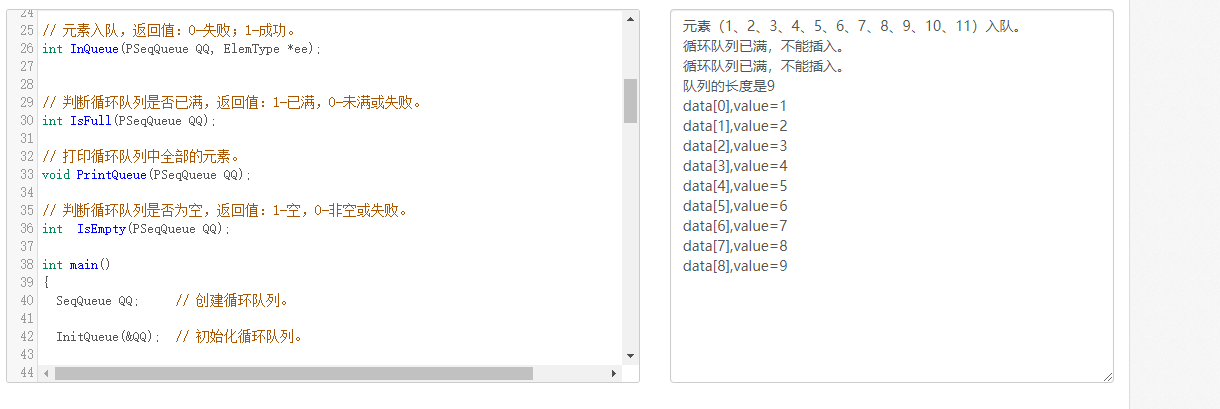
七、出队
// 元素出队,返回值:0-失败;1-成功。
int OutQueue(PSeqQueue QQ, ElemType *ee);
int main()
{
SeqQueue QQ; // 创建循环队列。
InitQueue(&QQ); // 初始化循环队列。
ElemType ee; // 创建一个数据元素。
printf("元素(1、2、3、4、5、6、7、8、9、10、11)入队。\n");
ee=1; InQueue(&QQ, &ee);
ee=2; InQueue(&QQ, &ee);
ee=3; InQueue(&QQ, &ee);
ee=4; InQueue(&QQ, &ee);
ee=5; InQueue(&QQ, &ee);
ee=6; InQueue(&QQ, &ee);
ee=7; InQueue(&QQ, &ee);
ee=8; InQueue(&QQ, &ee);
ee=9; InQueue(&QQ, &ee);
ee=10; InQueue(&QQ, &ee);
ee=11; InQueue(&QQ, &ee);
printf("队列的长度是%d\n",Length(&QQ));
PrintQueue(&QQ);
if (OutQueue(&QQ,&ee)==1) printf("出队的元素值为%d\n",ee);
if (OutQueue(&QQ,&ee)==1) printf("出队的元素值为%d\n",ee);
if (OutQueue(&QQ,&ee)==1) printf("出队的元素值为%d\n",ee);
if (OutQueue(&QQ,&ee)==1) printf("出队的元素值为%d\n",ee);
if (OutQueue(&QQ,&ee)==1) printf("出队的元素值为%d\n",ee);
if (OutQueue(&QQ,&ee)==1) printf("出队的元素值为%d\n",ee);
if (OutQueue(&QQ,&ee)==1) printf("出队的元素值为%d\n",ee);
printf("队列的长度是%d\n",Length(&QQ));
PrintQueue(&QQ);
return 0;
}
// 元素出队,返回值:0-失败;1-成功。
int OutQueue(PSeqQueue QQ, ElemType *ee)
{
if ( (QQ == NULL) || (ee == NULL) ) return 0; // 检查空指针。
if (IsEmpty(QQ) == 1) { printf("队列为空。\n"); return 0; }
memcpy(ee,&QQ->data[QQ->front],sizeof(ElemType)); // 用数组的下标访问。
// memcpy(ee,QQ->data+QQ->front,sizeof(ElemType)); // 采用指针运算也可以。
QQ->front=(QQ->front+1)%MAXSIZE; // 队列头指针后移。
return 1;
}
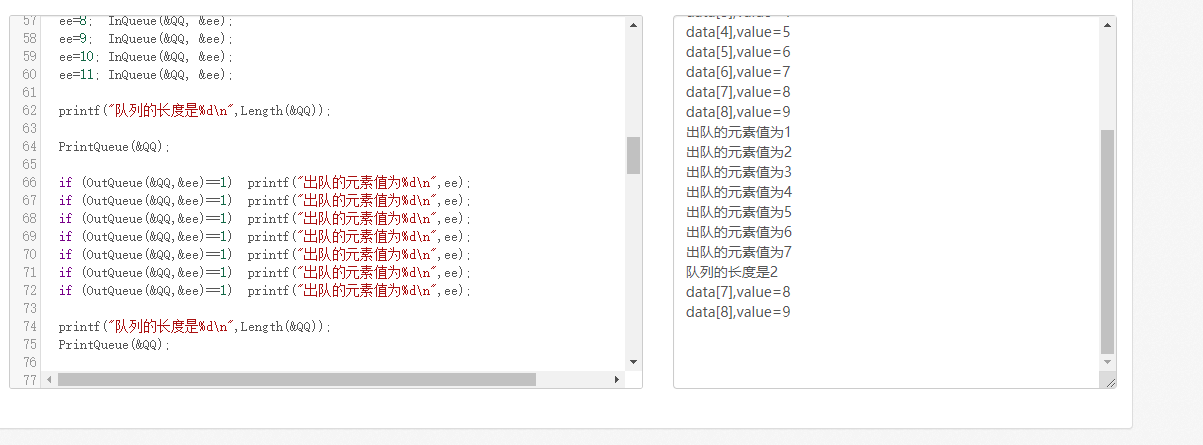
八、查看队头元素
// 获取队头元素,返回值:0-失败;1-成功。
// 只查看队头元素的值,元素不出队。
int GetHead(PSeqQueue QQ, ElemType *ee);
int main()
{
SeqQueue QQ; // 创建循环队列。
InitQueue(&QQ); // 初始化循环队列。
ElemType ee; // 创建一个数据元素。
printf("元素(1、2、3、4、5、6、7、8、9、10、11)入队。\n");
ee=1; InQueue(&QQ, &ee);
ee=2; InQueue(&QQ, &ee);
ee=3; InQueue(&QQ, &ee);
ee=4; InQueue(&QQ, &ee);
ee=5; InQueue(&QQ, &ee);
ee=6; InQueue(&QQ, &ee);
ee=7; InQueue(&QQ, &ee);
ee=8; InQueue(&QQ, &ee);
ee=9; InQueue(&QQ, &ee);
ee=10; InQueue(&QQ, &ee);
ee=11; InQueue(&QQ, &ee);
// 只查看队头元素的值,元素不出队。
if (GetHead(&QQ,&ee)==1) printf("队头的元素值为%d\n",ee);
return 0;
}
// 获取队头元素,返回值:0-失败;1-成功。
// 只查看队头元素的值,元素不出队。
int GetHead(PSeqQueue QQ, ElemType *ee)
{
if ( (QQ == NULL) || (ee == NULL) ) return 0; // 检查空指针。
if (IsEmpty(QQ) == 1) { printf("队列为空。\n"); return 0; }
memcpy(ee,&QQ->data[QQ->front],sizeof(ElemType)); // 用数组的下标访问。
// memcpy(ee,QQ->data+QQ->front,sizeof(ElemType)); // 采用指针运算也可以。
return 1;
}
九、完整代码
/*
* 程序名:seqqueue1.c,此程序演示循环队列的数组实现,队尾指针指向队尾的下一个元素,没有length的辅助变量。
* 作者:C语言技术网(www.freecplus.net) 日期:20201230
*/
#include <stdio.h>
#include <string.h>
#define MAXSIZE 10 // 循环队列的最大长度,最多可以存放MAXSIZE-1个元素。
typedef int ElemType; // 自定义循环队列的数据元素为整数。
typedef struct
{
ElemType data[MAXSIZE]; // 用数组存储循环队列中的元素。
int front; // 队列的头指针。
int rear; // 队列的尾指针,指向队尾的下一个元素。
}SeqQueue,*PSeqQueue;
// 循环队列QQ的初始化操作。
void InitQueue(PSeqQueue QQ);
// 销毁循环队列QQ。
void DestroyQueue(PSeqQueue QQ);
// 元素入队,返回值:0-失败;1-成功。
int InQueue(PSeqQueue QQ, ElemType *ee);
// 元素出队,返回值:0-失败;1-成功。
int OutQueue(PSeqQueue QQ, ElemType *ee);
// 求循环队列的长度,返回值:>=0-队列QQ元素的个数。
int Length(PSeqQueue QQ);
// 清空循环队列。
void Clear(PSeqQueue QQ);
// 判断循环队列是否为空,返回值:1-空,0-非空或失败。
int IsEmpty(PSeqQueue QQ);
// 判断循环队列是否已满,返回值:1-已满,0-未满或失败。
int IsFull(PSeqQueue QQ);
// 打印循环队列中全部的元素。
void PrintQueue(PSeqQueue QQ);
// 获取队头元素,返回值:0-失败;1-成功。
// 只查看队头元素的值,元素不出队。
int GetHead(PSeqQueue QQ, ElemType *ee);
int main()
{
SeqQueue QQ; // 创建循环队列。
InitQueue(&QQ); // 初始化循环队列。
ElemType ee; // 创建一个数据元素。
printf("元素(1、2、3、4、5、6、7、8、9、10、11)入队。\n");
ee=1; InQueue(&QQ, &ee);
ee=2; InQueue(&QQ, &ee);
ee=3; InQueue(&QQ, &ee);
ee=4; InQueue(&QQ, &ee);
ee=5; InQueue(&QQ, &ee);
ee=6; InQueue(&QQ, &ee);
ee=7; InQueue(&QQ, &ee);
ee=8; InQueue(&QQ, &ee);
ee=9; InQueue(&QQ, &ee);
ee=10; InQueue(&QQ, &ee);
ee=11; InQueue(&QQ, &ee);
printf("队列的长度是%d\n",Length(&QQ));
PrintQueue(&QQ);
if (OutQueue(&QQ,&ee)==1) printf("出队的元素值为%d\n",ee);
if (OutQueue(&QQ,&ee)==1) printf("出队的元素值为%d\n",ee);
if (OutQueue(&QQ,&ee)==1) printf("出队的元素值为%d\n",ee);
if (OutQueue(&QQ,&ee)==1) printf("出队的元素值为%d\n",ee);
if (OutQueue(&QQ,&ee)==1) printf("出队的元素值为%d\n",ee);
if (OutQueue(&QQ,&ee)==1) printf("出队的元素值为%d\n",ee);
if (OutQueue(&QQ,&ee)==1) printf("出队的元素值为%d\n",ee);
printf("队列的长度是%d\n",Length(&QQ));
PrintQueue(&QQ);
printf("元素(11、12、13、14、15)入队。\n");
ee=11; InQueue(&QQ, &ee);
ee=12; InQueue(&QQ, &ee);
ee=13; InQueue(&QQ, &ee);
ee=14; InQueue(&QQ, &ee);
ee=15; InQueue(&QQ, &ee);
printf("队列的长度是%d\n",Length(&QQ));
PrintQueue(&QQ);
// 只查看队头元素的值,元素不出队。
if (GetHead(&QQ,&ee)==1) printf("队头的元素值为%d\n",ee);
return 0;
}
// 初始化循环队列
void InitQueue(PSeqQueue QQ)
{
Clear(QQ); // 清空循环队列。
}
// 清空循环队列。
void Clear(PSeqQueue QQ)
{
if (QQ == NULL) return; // 检查空指针。
QQ->front=QQ->rear=0;
memset(QQ->data,0,sizeof(ElemType)*MAXSIZE); // 数组元素清零。
}
// 求循环队列的长度,返回值:>=0-队列QQ元素的个数。
int Length(PSeqQueue QQ)
{
if (QQ == NULL) return 0; // 检查空指针。
return (QQ->rear-QQ->front+MAXSIZE)%MAXSIZE;
}
// 销毁循环队列QQ。
void DestroyQueue(PSeqQueue QQ)
{
// 静态循环队列无需释放内存,不需要销毁操作。
Clear(QQ); // 清空循环队列。
return;
}
// 判断循环队列是否为空,返回值:1-空,0-非空或失败。
int IsEmpty(PSeqQueue QQ)
{
if (QQ == NULL) return 0; // 检查空指针。
if (QQ->front == QQ->rear) return 1;
return 0;
}
// 判断循环队列是否已满,返回值:1-已满,0-未满或失败。
int IsFull(PSeqQueue QQ)
{
if (QQ == NULL) return 0; // 检查空指针。
if ( ((QQ->rear+1)%MAXSIZE) == QQ->front) return 1;
return 0;
}
// 元素入队,返回值:0-失败;1-成功。
int InQueue(PSeqQueue QQ, ElemType *ee)
{
if ( (QQ == NULL) || (ee == NULL) ) return 0; // 检查空指针。
if (IsFull(QQ) == 1)
{
printf("循环队列已满,不能插入。\n"); return 0;
}
memcpy(&QQ->data[QQ->rear],ee,sizeof(ElemType)); // 用数组的下标访问。
// memcpy(QQ->data+QQ->rear,ee,sizeof(ElemType)); // 采用指针运算也可以。
QQ->rear=(QQ->rear+1)%MAXSIZE; // 队尾指针后移。
return 1;
}
// 打印循环队列中全部的元素。
void PrintQueue(PSeqQueue QQ)
{
if (QQ == NULL) return; // 检查空指针。
if (IsEmpty(QQ) == 1) { printf("队列为空。\n"); return; }
int kk,qlen=Length(QQ);
for (kk = 0; kk < qlen; kk++)
{
// 用数组的下标访问。
printf("data[%d],value=%d\n",(QQ->front+kk)%MAXSIZE,QQ->data[(QQ->front+kk)%MAXSIZE]);
// 采用指针运算也可以。
// printf("data[%d],value=%d\n",(QQ->front+kk)%MAXSIZE,*(QQ->data+(QQ->front+kk)%MAXSIZE));
}
}
// 元素出队,返回值:0-失败;1-成功。
int OutQueue(PSeqQueue QQ, ElemType *ee)
{
if ( (QQ == NULL) || (ee == NULL) ) return 0; // 检查空指针。
if (IsEmpty(QQ) == 1) { printf("队列为空。\n"); return 0; }
memcpy(ee,&QQ->data[QQ->front],sizeof(ElemType)); // 用数组的下标访问。
// memcpy(ee,QQ->data+QQ->front,sizeof(ElemType)); // 采用指针运算也可以。
QQ->front=(QQ->front+1)%MAXSIZE; // 队列头指针后移。
return 1;
}
// 获取队头元素,返回值:0-失败;1-成功。
// 只查看队头元素的值,元素不出队。
int GetHead(PSeqQueue QQ, ElemType *ee)
{
if ( (QQ == NULL) || (ee == NULL) ) return 0; // 检查空指针。
if (IsEmpty(QQ) == 1) { printf("队列为空。\n"); return 0; }
memcpy(ee,&QQ->data[QQ->front],sizeof(ElemType)); // 用数组的下标访问。
// memcpy(ee,QQ->data+QQ->front,sizeof(ElemType)); // 采用指针运算也可以。
return 1;
}







